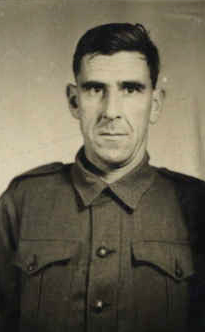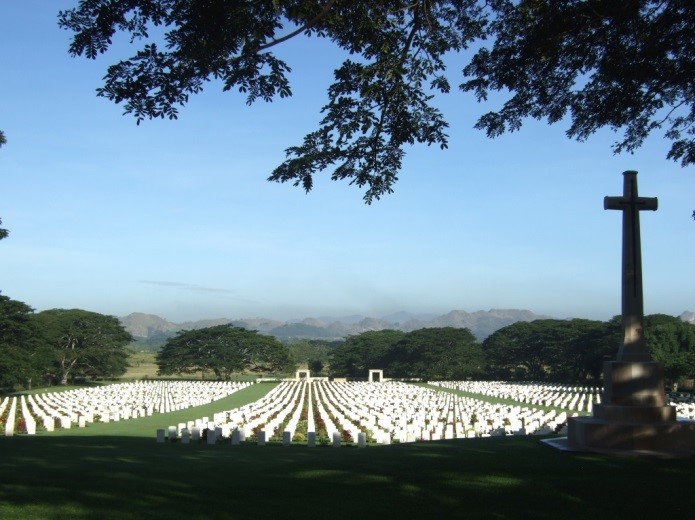Sergeant Archibald Hamilton Graham, the son of George Hamilton Graham and Ethel Graham (nee Wilson), was born at Esk in Queensland on 14th January 1902. He was educated at the Toowoomba Church of England Preparatory School and later attended the Toowoomba Grammar School. At the age of 38 years and 6 months he voluntarily enlisted in the Australian Imperial Force at Kelvin Grove in Brisbane on 30th July 1940 after swearing the statutory oath of allegiance. At the time of his enlistment he was unmarried, employed as a Business Manager and residing at “Ettswold” at Esk in Queensland. He had no previous military experience. His physical description was that he had black hair and brown eyes. He stated that he was of the Church of England religion. He gave his next of kin as his father, Mr George Hamilton Graham, c/- Capper & Co., Quilpie, Queensland.
Sergeant Archibald Graham was allotted the regimental number of QX17512. He joined the Grovely Depot on 21st July 1940. He was granted special leave during the period 18th August until 4th September 1940. He was allocated to the 1st Reinforcements of the 2nd/25th Infantry Battalion at Redbank on 26th September 1940. The 2nd/25th Infantry Battalion was formed at Grovely on 1st July 1940. He joined the 2nd/25th Infantry Battalion at Redbank Camp on 31st October 1940. He was granted pre-embarkation leave during the period 18th February until 28th February 1941 to farewell his family and finalize his personal affairs in preparation for overseas service with the Australian Imperial Force. He attended a course of instruction at the Northern Command Non Commissioned Officers’ School at Redbank during the period 7th March until 21st March 1941.
Sergeant Archibald Graham’s battalion left Brisbane by rail transport on 6th April 1941 and proceeded to Sydney where they boarded a transport ship “Queen Mary” on the following day. The “Queen Mary” departed Sydney for the Middle East early in the morning of the 9th April. The Queen Mary sailed via Fremantle in Western Australia to Trincomalee Harbour, Ceylon. After leaving Trincomalee the ship sailed to Aden and the Red Sea. It arrived at Port Tufik at the entrance to the Suez Canal on 3rd May 1941. The Battalion disembarked from the ship on 5th May 1941 and proceeded by rail transport to Ikingi Maryut. The Battalion then moved to Mersa Matruh on 9th May 1941 and arrived there shortly after midnight. The Battalion proceeded to Ismailia on 27th May and crossed the Suez Canal by ferry to El Kantara on the Palestine side.
Sergeant Archibald Graham was evacuated to the 7th Australian General Hospital on 9th August 1941 and he remained a patient there until discharged to the 24th Australian Infantry Training Battalion on 18th August 1941. He rejoined the 2nd/25th Infantry Battalion in the field in Syria where it was on garrison duty on 26th August 1941. On the day he rejoined his battalion he was appointed to the rank of Lance Corporal. He was promoted to the rank of Acting Corporal on 11th January 1942 and appointed to the rank of Lance Sergeant on 21st January 1942. He embarked with his Battalion on the “U.S.S. Mount Vernon” on 8th February 1942 to return to Australia to meet the Japanese threat. The ship arrived at Colombo on the morning of 18th February 1942. The ship left Colombo and arrived at Fremantle on 4th March 1942. The ship set sail for Adelaide and the Battalion disembarked there on the morning of 10th March 1942. The Battalion then moved to Woodside Camp where further military training was carried out. The Battalion moved to Casino in New South Wales during 26th/27th April 1942. On 27th May 1942 the Battalion moved to Caboolture in Queensland where it was assigned a portion of the coast for coast watching. Sergeant Archibald Graham was granted home leave during the period 2nd May until 11th May 1942. He was admitted to the 112th Australian General Hospital suffering an abdominal injury on 25th June 1942. He remained a patient at the hospital until 2nd July 1942 when he was discharged to the General Details Depot. He rejoined his battalion at Caboolture in Queensland on 3rd July 1942.
The battalion embarked from New Farm Wharf in Brisbane on 31st August 1942 on the ships S.S. Katoomba and S.S. Van Der Lijn and he disembarked at Port Moresby on 9th September 1942. The battalion moved to a staging camp near Murray Barracks outside of Port Moresby. The battalion left the staging camp at Port Moresby and proceeded up the Kokoda Track to engage the retreating Japanese. He was detached for duty with the 25th Brigade Carrier Group during the period 11th September 1942 until 21st January 1943. He embarked New Guinea 21st January 1943 and disembarked Australia on 23rd January 1943. He was promoted to the rank of Acting Sergeant on 16th March 1943 and his rank was confirmed on 24th April 1943. His battalion again embarked for service in New Guinea from the port of Townsville on H.M.A.S. “Duntroon” on 19th July 1943 and he disembarked at Port Moresby on 22nd July 1943. On 7th September 1943 his battalion was flown to Nadzab Strip. He was admitted to the 2nd/6th Australian Field Ambulance Unit on 2nd October 1943 suffering from malaria and he was transferred to the 2nd/11th Australian General Hospital on 4th October 1943.
Sergeant Archibald Hamilton Graham died as a result of malaria and scrub typhus at Dobadura whilst on active service on 20th October 1943. At the time of his death he was 41 years of age. He was buried in the Soputa War Cemetery. After the war his remains were exhumed and reburied in the Port Moresby (Bomana) War Cemetery. Archibald Graham’s headstone in the Port Moresby (Bomana) War Cemetery contains the family inscription “Dearly Loved”.
Archibald Hamilton’s name is recorded on Panel No. 52 at the Australian War Memorial in Canberra and locally on the Toowoomba Grammar School World War 2 Honour Board. For his service during World War 2 he had entitlement for the 1939/1945 Star, the Africa Star, the Pacific Star, the Defence Medal, the War Medal and the Australian Service Medal 1939/1945.
The following was published in the Pittsworth Sentinel on 6th November 1943:
Widespread sympathy was felt throughout the Pampas district towards the close of last week when it was learned that Mr and Mrs V.W. Fysh had received the sad tidings that Mrs Fysh’s brother, Sergeant Archie Hamilton Graham, had paid the supreme sacrifice in New Guinea. Sergeant Graham saw extensive service in the Middle East before going to New Guinea. He took part in the battle for Lae, and it was there that fate decreed that Sergeant Graham be asked to lay down his arms. On hearing the sad news, Mr and Mrs Wyngate Fysh and their children journeyed to Esk to see Mrs Fysh’s bereaved mother.
Note
A detailed history of the 2nd/25th Infantry Battalion during World War 2 can be found in Allan Draydon’s publication, “Men of Courage – What we have we hold”. Australian Military History Publications, Loftus 2232, Australia. 2001. ISBN 0-646-38663-8. The publication contains a nominal roll and a roll of honour.
His mother applied for and received the Female Relative Badge with one star and the Mothers’ & Widows’ Badge with one star on 1st December 1943.
Toowoomba Grammar School archive records show that he enrolled as a boarder on 1st January 1915. He became a day student in 1918/1919 and he left the School on 31st December 1919. He completed the Junior Public examination in 1917 passing eight subjects. His parent was shown as Mr George Hamilton Graham, “Ettsvold”, Esk. Whilst a student at the School he participated and showed excellence in a large number of sports. He was both a prefect and dux of the School. After leaving school he entered a pastoral career in the Charleville & Quilpie districts. He was Manager of Capper & Co., Stock & Station agents of Quilpie.
Mr John Tannock, the son of a former Quilpie resident and World War 2 veteran, gave the following address prepared by his father at an Anzac Day ceremony at Quilpie in 1999:
“I want to tell you a story of a man you won’t read about in history books. A man who would not be known outside his circle of friends, but a man whose spirit was typical of the men and women who have been prepared to sacrifice their lives in order that you enjoy the freedom you have today. The story I want to tell you is that of Archie Graham. There may be some present here today who remember him because, like you boys and girls, Archie grew up in a small country town. Like you he would have gone to the local school and would have enjoyed doing lots of things that you do today. Archie was a very bright boy and did very well at school, eventually going on to be dux of the Toowoomba Grammar School.
As a young man he worked in the Quilpie district, managing Pinkilla Station and later moving into the town of Quilpie as manager of Capper & Company. Archie enlisted in 1940 and joined my battalion the 2nd/25th, where he rose to the rank of Sergeant in the mortar platoon. With his scholastic ability Archie could have commanded a position of rank in Staff and Administration duties away from the dangers of the battlefield. Instead, he chose to play his part and serve in the front line. In 1943, our battalion was involved in the capture of Lae in New Guinea. During that battle it became vital to bring accurate mortar fire onto the Japanese positions in order to dislodge them. Archie crawled forward in order to direct the bombs more accurately onto the enemy positions. In fact he got so close to where he was directing the bombs that one actually blew the end off his rifle! Nevertheless, Archie’s efforts that day played a big part in being able to capture the town of Lae from the Japanese.
Sadly, Archie never made it back to Australia and Quilpie. Before our battalion was relieved, Archie became ill with the deadly scrub typhus disease and passed away. The point of this story, boys and girls, is not to glorify war. Instead, it is to make you aware of the sacrifice that many young Australians such as Archie Graham from Quilpie have made, so that we are able to live in peace and freedom.”




